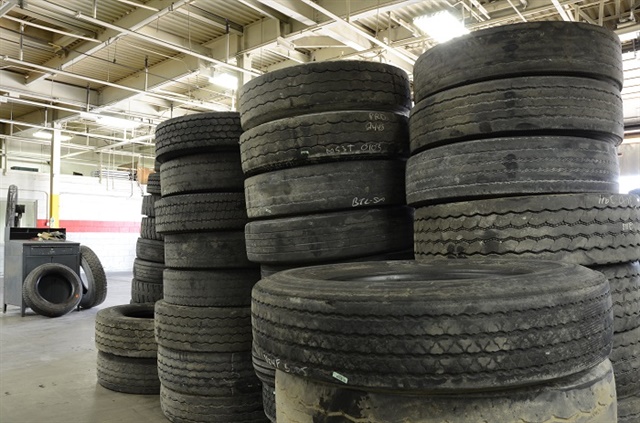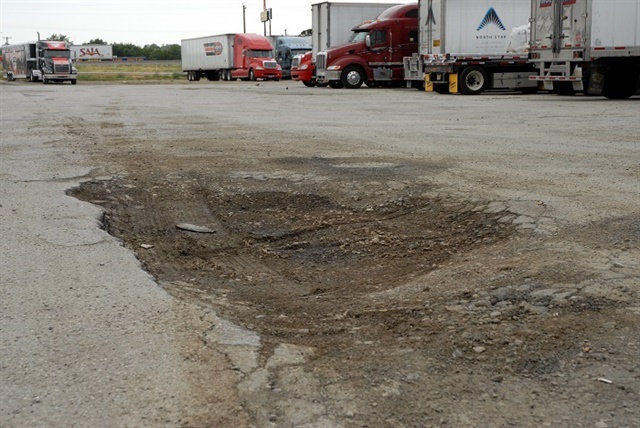
Tire service providers and retreaders can be a great source of failure analysis if the unit number and wheel position are tracked. Photos: Jim Park
What’s Wrecking Your Tires?
It’s said that dead men tell no tales. Dead tires, however, sure do. Ignore them, and you do so at your expense. Since tires rarely self-destruct, there is always a smoking gun, and it’s in your best interest to find it. You do that through failure analysis.
An expert can tell at a glance what’s happening to a tire, often by just looking at it or rubbing a hand over the tread face. Tire wear, you see, isn’t the tire’s fault. There’s something wrong with the truck that’s aggravating the situation. You must fix that to arrest the tire wear. So where do you start?
If you do not have the luxury of an in-house expert, a service provider can probably help. Jeff Lecklider, president of Gem City Tire in Dayton, Ohio, performs that service for dozens of fleet customers.
“We work with the customer to help them to reduce their tire costs, and we usually start with a fleet survey,” he says. “We’ll give them a baseline of the condition of their fleet, including tread depth, air pressure, any tire conditions, irregular wear, flat tires, etc., and then we recommend a course of action. We do this regularly so we can spot problems as soon as they become visible.”
Various mechanical problems leave telltale signs on tires. Take cupping and scalloped wear on a steer tire. That’s usually caused by some non-uniformity in the tire/wheel assembly, such as non-concentric mounting or a moderate to severe out-of-balance condition. Feathered wear on a steer tire is another easy one – it’s a sign of misalignment. But which misalignment condition? Here you might need to dig a little deeper. It could be an excessive toe-in condition. It could be drive axle misalignment creating a side thrust. Or it could be a bent tie rod.
“Tires are symptomatic,” says tire expert and semi-retired consultant Asa Sharp. “There are a variety of other things on the truck that cause the wear. For that reason, it’s very important to conduct a thorough out-of-service analysis when the tire comes off the truck, or if you’re smart about it, during the regular fleet tire surveys — before the tires hit the scrap pile.”

During, after, and before
It obviously makes sense to monitor in-service tire performance, watching for irregular wear and mechanically induced damage, but tracking wear and using that insight for future tire purchases really pays off. Tire tracking can be tedious, but it is getting easier. Most maintenance software platforms enable tire tracking, and some of the tire pressure monitoring systems offer the ability to self-populate those databases.
“On top of providing real-time tire pressure and temperature readings and alert schedules, we’re also able to provide fleets with historical performance data to unlock tire performance trends,” says Vanessa Hargrave, CMO of Advantage PressurePro. “We’re now able to help fleets move their tire maintenance programs from reactive to proactive.”
When Kirk Altrichter was vice president of maintenance at Crete Carrier Corp. (he’s now vice president of fleet services at Kenan Advantage Group), he participated in a Tire Benchmarking panel discussion at a TMC meeting where he revealed some of the benefits of a diligent tracking program.
“With my supplier, we have been watching which tires fail at what wheel positions,” he said. “It was interesting but not unexpected that the right rear outer trailer was the most failure-prone position. We also found an unexpectedly high number of failures of the left rear inner tires.
“It’s all about trying to take cost out by identifying problems before they occur on the road. For the past several years we have tried to ensure we have the right tire at the right wheel position,” he added.

If staying on top of your tires while they are still on the truck is too tall an order, there is always the fleet yard survey, or as a last resort, an objective study of your tire scrap pile. It’s too late for that tire once it hits the scrap pile, but if you kept a record of what truck and wheel position it came from, you can still glean some insight from it.
“You’re conducting a post-mortem of sorts,” Sharp says. “It’s easy to determine what happened to the tire. Even if you can’t make that determination yourself, your vendor or the TMC Tire Condition guides can help. Every type of calamity to befall a tire leaves a fingerprint.”
Most regrettable are tires that go missing in action. Their story is likely to remain untold unless the roadside repair service can determine the cause of the failure or get the carcass back to you. It’s estimated that about 80% of on-road tire failures not caused by a road hazard are the result of creeping air loss, or under-inflation. Keeping those tires properly inflated would likely have saved them.
FleetNet America recently produced a maintenance benchmarking report demonstrating the difference in various maintenance practices. In the tire category, for example, results of their collected data showed that the average fleet in the survey experienced on-road tire repair/replacement events every 35,166 miles. The worst-in-class fleet put in a service call every 34,438 miles. Astonishingly, the best-in-class fleet in the reporting group saw a service call frequency at half the rate of the worst fleet, with an event occurring only once every 71,238 miles. Those are averages, of course, but it shows pretty clearly that a bit of tire maintenance can go a really long way.
That fleet, and those like it, probably pay a lot more attention to their tires before and during their service life, rather than after.
Source: https://www.truckinginfo.com
 I´m a Fleet Management expert, and the manager of Advanced Fleet Management Consulting, that provides Fleet Management Consultancy Services.
I´m a Fleet Management expert, and the manager of Advanced Fleet Management Consulting, that provides Fleet Management Consultancy Services.
18º CURSO PARA LA GESTIÓN DE FLOTAS DE VEHÍCULOS-Barcelona 9-10-11 de Octubre 2019
Advanced Fleet Management Consulting, en colaboración con Jaltest, GantaBI, Optimatics y Transporte Profesional, organizan el “Curso para la Gestión de flotas de vehículos” con el fin de formar a los profesionales en gestión de flotas a tomar una visión global y conocer todas las actividades y factores clave involucrados en la gestión de una flota de vehículos. El curso es único en España y presenta un enfoque innovador al desarrollar una metodología propia para la gestión de flotas de vehículos.
Pincha en el siguiente enlace para saber más:
18º CURSO PARA LA GESTIÓN DE FLOTAS DE VEHÍCULOS-Barcelona 9-10-11 de Octubre 2019



